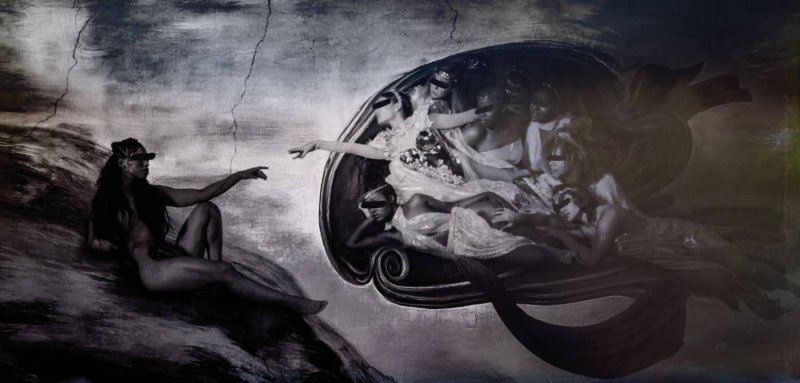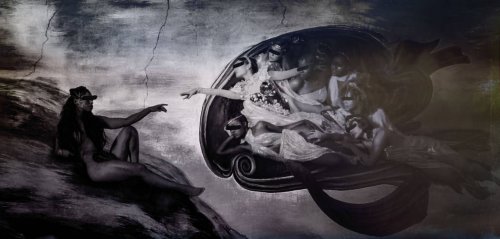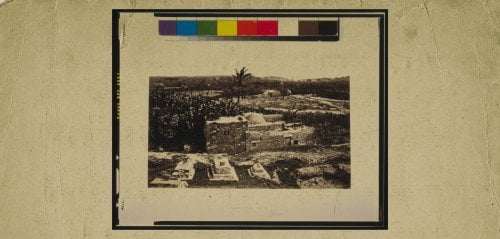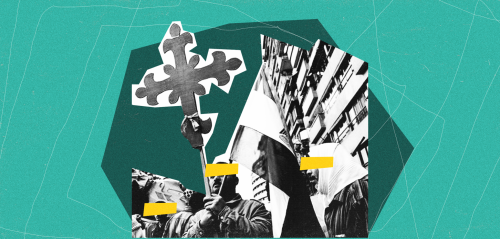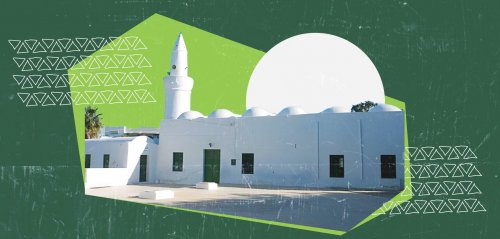I am the mother of all things, mother of the universe, mistress of all the elements and the beginner of worlds, first-born of the ages, highest of the gods, queen of the shadows, first of those who dwell in heaven, representing in one shape all gods and goddesses, the center of divine power. My will controls the shining heights of heaven, the health-giving sea-winds, and the mournful silences of hell; the entire world worships my single godhead in a thousand shapes, with different rituals, and under many different names.… [but] my true name is: Queen Isis. I am here in pity for your misfortunes, I am here with favor and goodwill. Stop now your weeping, banish your grief: And to it [my name], turn in prayer.
— Isis, Queen of Heaven (circa 155 CE)
The above text is from an ancient Egyptian inscription, translated by the American mythologist Joseph Campbell in his book Primitive Mythology.
The Egyptian goddess Isis describes herself with similar traits to those of Hathor, Inanna, Ishtar, Nidaba, Ninhursag, Astarte, Brigid, and Aphrodite, among other female deities revered in ancient civilizations including Egypt, Babylon, Sumer, Assyria, Elam, India, and others, before the advent of the Abrahamic religions, Judaism, Christianity, and Islam.
In his book The Mystery of Ishtar, Firas al-Sawwah, a mythology researcher, suggested that the goddess is one and the same in all ancient civilizations, even if her names varied.
God between Islam, Judaism and Christianity
In the Abrahamic religions, God is spoken of in the masculine form, whether metaphorically as in Islam, or literally as in Christianity and Judaism.
In the case of Islam, which adopted Arabic as the language of its holy book, the use of the masculine form when referencing God was a linguistic necessity, as the Arabic language largely requires the presence of a gendered pronoun.
In the case of Islam, which adopted Arabic as the language of its holy book, the use of the masculine form when referencing God was a linguistic necessity, as the Arabic language largely requires the presence of a gendered pronoun.
In Arabic, the sun is feminine and the moon is masculine, and although they are not subject to gender classification, linguistic necessity dictated the feminization of the sun and the masculinization of the moon.
Similarly, the Quran states, "{There is nothing like Him}," referring to God, according to Surah Ash-Shura, implying that God, He, does not fall under any classifications of any kind. Similarly, Surah Al-Ikhlas outlines, "{Say, He is Allāh, the One and Only; Allāh, the Eternal Refuge. He neither begets nor is born, Nor is there to Him any equivalent}."
In his study ‘God and Gender in Islam,’ Mustafa Çevik, a researcher at the Turkish University of Adiyaman, includes evidence and theories refuting the idea that God is not gendered in Islam.
According to Çevik, some Muslim scholars refer to God in the masculine, basing their beliefs on less reliable traditional evidence than the Quran, which denies this.
In Judaism and Christianity, the perception is that God is an older white male, deriving his image from that of a king or father, as feminist theological historian Carol P. Christ explains in her study, ‘She who Changes: Re-Imagining the Divine in the World’.
In Christianity, God is referred to as the Father, not the Mother, and His Son, Jesus Christ, is male. The church interprets and understands this gendering from the Holy Bible.
According to Ephesians 5:22-23, Saint Paul the Apostle says, “Wives, be subject to your husbands, as to the Lord. [23] For the husband is the head of the wife as Christ is the head of the church, his body, and is himself its Savior. [24] As the church is subject to Christ, so let wives also be subject in everything to their husbands.”
The Acts of the Apostles, explains, “Jesus of Nazareth was a man accredited by God to you by miracles, wonders and signs, which God did among you through him, as you yourselves know.” Christian divine revelation clearly declares a close relationship between fatherhood (deity) and authority.
In the beginning, the deity was feminine
Before the advent of the Abrahamic religions, the ancient civilizations' perception of the deity was feminine. This perception is inseparable from the cultural context, social relationships, and the dominant status of women in those societies.
Before history was written and in early recorded history, there were religions found where people sanctified their deity or god as female. Many researchers support this idea.
The archaeologist James Mellaart mentions in his book Earliest Civilizations of the Near East that in the Middle East, the goddess was worshiped seven to nine thousand years before the birth of Christ.
Sanctifying the deity in its feminine form is tied to two main systems: the matriarchal social system and the agricultural production system.
Walther Hinz, director of the Institute for Iranian Studies at the University of Göttingen in Germany, agrees in his book The Lost World of Elam. According to him, in the civilization of Elam, in the Ahvaz region of western Iran today, the main deity, surpassing all Elamite gods, was a goddess.
Hinz explains that until the third millennium BCE, and in the second millennium, the people of Elam worshiped the goddess of Elam. However, her popularity began to decline in favor of masculinized deities, and Humban, her husband, gained greater sanctity.
In her book When God Was a Woman, American historian and researcher Merlin Stone confirms that 'the Great Goddess', the sacred grandmother, was worshiped from the beginnings of the Neolithic era, around 7,000 years BCE, in Palestine (Canaan), that went on to be the cradle of Judaism and Christianity.
Before the Abrahamic religions, the ancient civilizations' perception of deity was feminine. This perception is tied to the cultural context, social relations, and the dominant status of women in ancient societies.
Society continued to worship the Great Goddess, although less prominently, until the Israelites eliminated this after the birth of Judaism, which began with the prophet Abraham about 1,800 years before the birth of Christ, and then with his children and descendants, starting with Isaac and Ishmael.
Jacob (Israel) came from Isaac’s lineage, and was the father, grandfather and ancestor of Joseph, Moses, David, Solomon, and others, and finally, Christ, who from his maternal side, is related to the children of Israel.
Muhammad, the Prophet of Islam, was also born from this lineage, although much later, with Islam emerging much later, in the seventh century AD.
The Abrahamic religions treated the worship of female deity as idolatry and pagan worship, due to the statues people worshiped. An order was issued to eliminate such statues, as stated by the Book of Deuteronomy in the Old Testament, “You shall utterly destroy all the places where the nations whom you shall dispossess serve their gods, on the high mountains and the hills and under every green [leafy] tree. You shall tear down their altars and dash in pieces their pillars and burn their Asherim with fire. You shall chop down the carved images of their gods and destroy their name out of that place.”
After the advent of Judaism came Christianity, and later, Islam; none of the three Abrahamic religions tolerated the ancient religions. Christians reintroduced the idea of sacred icons and pagan religions, especially after the rule of the Christian Emperor Theodosius, then went on to persecute those they described as pagans, destroying their temples and idols.
However, this systematic destruction did not succeed in eliminating all traces of female deity, as many sacred ancient statues with female forms survived.
Perhaps it can be said that the Quran contains the clearest text against the feminine deity, despite not explicitly calling for the masculinization of God. In Surah An-Nisa, polytheistic pagan goddesses are explicitly described as feminine, where the verse says: "{They call upon instead of Him none but female [deities]}".
Al-Tabari presents more than one interpretation of the above verse, suggesting that the disbelievers of the Quraysh used to call upon female deities and idols aside from Allah, considering that "al-Lāt and al-‘Uzzā, Manat, and Na'ila" were considered feminine deities by the Quraysh.
This is almost universally accepted by many Arabic sources, which confirms that these deities, eliminated by Islam, were feminized. Examples include "Kitab Akhbar Makkah" by Abu al-Waleed al-Azraqi and "Kitab Al-Asnam" ('The Book of Idols') by Hisham ibn al-Kalbi.
Marlin Stone considers that placing blame on Eve for Adam's expulsion from paradise, according to the Old Testament, is indicative of the Israelites' attempt to distort and tarnish the reputations of female goddess.
Between motherhood and fertility: Reasons for the feminization of the deity
Sanctifying the deity in its feminine form stems from the ancient world’s prevalent matriarchal social system and agricultural production system, according to Orientalist and scholar William Robertson Smith.
In his book Religion of the Semites, he argues that the female deity in the Semitic civilizations in the Middle East was sanctified directly as a result of the matriarchy in those societies.
In the Abrahamic religions, God is referred to in the masculine, whether metaphorically, as in Islam, or literally as in Christianity and Judaism.
In ancient Semitic society, children’s names were attributed to their mothers, not their fathers. It was the mother who held authority in the family. It was logical for the deity to be feminine rather than masculine. Matriarchal society was a feature of the ancient world. Ultimately, after the rise of the Abrahamic religions, the Semites fought against a matriarchal society.
Beyond the Middle East, the matriarchal system was prevalent in various other regions across the world, according to Scottish anthropologist James George Frazer. According to Frazer, one such example is the Paleo clan from Micronesia, where women were politically and socially superior to men, and consequently, the female goddess was sacred to them.
The perception of divinity was a reflection of societal structure. Even if the female goddess was married to a male god, she held authority over him, and the son of the goddess, in this context, was also considered a lesser deity, according to Frazer. Men were considered a mere tool for reproduction, while women were responsible for conception, pregnancy, and childbirth. She gives life, and this attribute is holy.
For men, the female body was an object of love and desire, yet it was also a source of awe and fear. From her body, new life emerged, and from her breasts, the child feeds on milk necessary for nourishment and growth. For many men, the most frightening aspect was that a woman’s monthly menstrual cycle echoed the lunar cycle.
This view of the female body was echoed in popular perceptions of the goddess. According to Firas Al-Sawwah, this is the reason for which statues of goddesses, across various ancient Mediterranean civilizations, were often depicted holding their breasts as though to breastfeed.
The formation of civilization began with human settlement and the development of agriculture. The land that man cultivated became sacred, producing food and fuel. This notion was also reflected in divinity and its feminization. According to Al-Sawwah, the modern Neolithic era followed an agricultural religion.
At that time, man found that the woman was like the earth; Planting a seed in the earth and watching it give birth to a tree, fruit and life, is not dissimilar to a man placing his sperm in a woman's womb, resulting in her carrying and giving birth to a human being. Women and the earth became the same, working together, delivering fertility and life. Since women give life, the heavenly and universal deity must also be female. Statues of female goddesses were sometimes depicted with their hands raising stems of wheat or riding on the backs of animals used in agriculture.
How did masculinized deity triumph over feminized deity?
As previously mentioned, social systems influenced the theological system. In the early stages of the agricultural system, and with the dominance of the matriarchal society, human perception of the deity was purely feminine.
When goddesses married and delivered children, their sons became gods, and so did their husbands. Although the goddess dominated over her sons and husband, men eventually gained control over more social structures and roles, garnering greater authority over women, and the masculinized deity gradually gained prominence at the expense of the feminized deity.
When the Ancient Egyptian goddess Nut married the god Geb, she bore two gods, Isis and Osiris, who later married each other, as sibling marriage was natural at that time.
Isis gave birth to the god Horus, who was nursed by Isis's mother, Nut, and he came to symbolize the sun. Over time, Horus united with the god Ra, and Ra became Ra-Horakhty, dominating over the earth, the sky, and the entire universe.
The perception of divinity reflected societal structure. Female goddesses held authority over their husbands. Men were considered tools for reproduction, whereas women were responsible for conception, pregnancy, and childbirth. She gives life, and this was considered a holy attribute.
Later, the god Amun, the greatest deity in ancient Egypt during the era of the New Kingdom, was associated with Ra and called himself Amun-Ra. Dominance shifted to the male god, despite the presence of female gods.
Despite the dominance of the male god and male kings, the status of women in Egypt remained important even after the end of the New Kingdom, as evidenced in Herodotus’ book, The Histories, after he visited Egypt.
Despite ancient Egyptian civilization having declined by the time Herodotus visited in the fifth century BCE, traces of ancient culture persisted, and Egyptian gods and goddesses were still considered sacred. Women in family life held significant status because inheritance descended through the mother, not the father. This is a state that harks back to prehistoric times, during the dominance of matriarchy and the subsequent dominance of feminine deities.
Herodotus also observed that, during his visit, women were active, walking in markets, engaging in public affairs, and working, similarly to men. Some men even stayed at home, working in fabric production, spinning, and weaving, while women managed the external affairs of the household.
Ultimately, men and the masculine deity were favored. The Abrahamic religions cast their influence on human civilization, and the matter was conclusively settled after the dominance of Christianity, closing the chapter on feminine deity.
Raseef22 is a not for profit entity. Our focus is on quality journalism. Every contribution to the NasRaseef membership goes directly towards journalism production. We stand independent, not accepting corporate sponsorships, sponsored content or political funding.
Support our mission to keep Raseef22 available to all readers by clicking here!
Interested in writing with us? Check our pitch process here!
